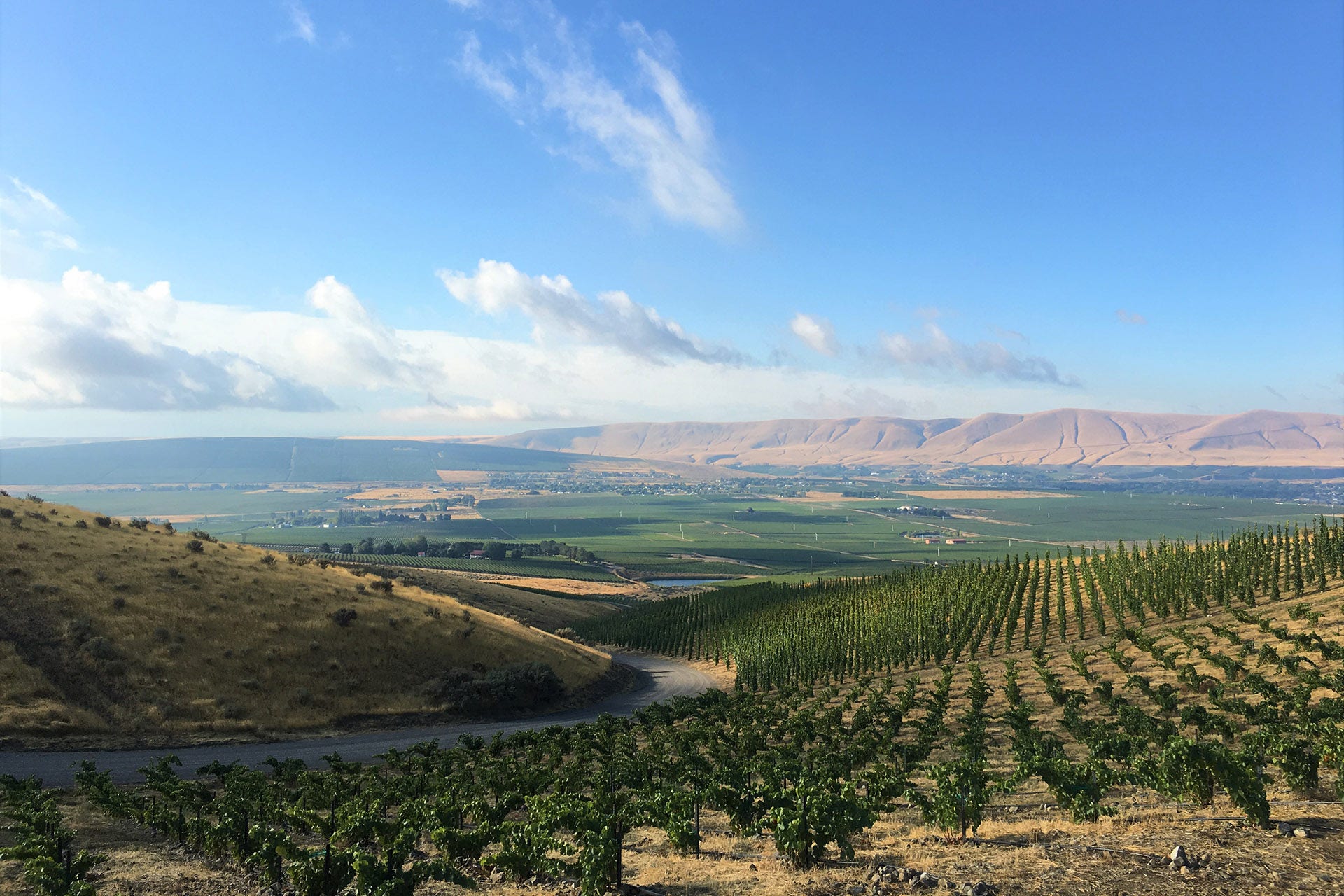As producers and winemakers in Washington continue to explore the boundaries of what is possible for viticulture in the state, a number are looking in a new direction: up.
“Historically, if you go way back in Washington, you needed to be at a lower elevation in order to get the heat units to ripen fruit,” says Marty Clubb, co-owner/managing winemaker at L’Ecole No. 41 in the Walla Walla Valley. “With overall global warming, you’re now seeing harvest starting in August, which was unheard of 25 years ago. All of the sudden, having vineyards at higher elevation makes sense.”
Two factors in particular make higher-elevation vineyards intriguing in Washington: soil and temperature. Most of eastern Washington’s vineyard soils are defined by the Missoula Floods, a series of cataclysmic events 15,000 years ago that left gravelly deposits with layers of sand and silt on top. However, some higher elevation vineyards—those at least 1,200 feet above sea level—remained above the floods, and therefore have a different soil composition.
“It was a challenge to get a handle on what might be farmable, because it was on the top of Red Mountain, and doggone it, no one had ever done that.” —Ryan Johnson, vineyard manager and partner, WeatherEye Vineyard
“To me, the lower sites tend to be early ripening, kind of simple wines,” says Brennon Leighton, director of winemaking at Wines of Substance. “Above the floods, you have everything from caliche to basalt to chalk to a mixture of those. The higher you go, you get more complex wines and more minerality.”
Soil depth can also be thinner at these altitudes, causing the growing season to begin earlier.
“What causes your vines to bud out is soil temperature,” says Clubb. “If your soils are shallow, they warm up faster, so you bud out sooner than you might expect.”
However, the higher elevation often means a lower daytime temperature, which slows development and extends the growing season later into the year. This leads to longer hang time and additional flavor development. Better still, the lower temperatures result in less sugar accumulation in the grapes, which lowers potential alcohol in the resulting wines. The temperatures also help the grapes retain natural acidity.
“We’re getting to ripen later in the year with less sugar, higher acid and more complexity,” says Leighton of the higher elevation vineyards he works with. “This is a no brainer to me.”

Red Mountain Elevated
By far the most ambitious higher-elevation project underway in Washington is a new series of plantings atop Red Mountain, called WeatherEye Vineyard. Over the last 14 years, investor Cam Myhrvold purchased 360 acres on the mountain’s upper reaches, which includes acreage on the previously unfarmed north side.
To date, 27 acres have been planted, with the first fruit harvested earlier this month.
“It’s part of Red Mountain, of course, but different from anything else in terms of the elevation, the steepness, the exposure, the soil depth and the temperature,” says Myhrvold. He says the site has significant climatic differences.
“We are typically five to seven, even nine degrees cooler than vineyards lower down,” says Myhrvold. “That may not be ‘better,’ but it’s different, and we think it’s interesting. We think it’s something we can exploit with the vines.”
For the project, Myhrvold has partnered with highly regarded grower Ryan Johnson, who has 19 vintages of experience on the mountain. He’s worked at prestigious sites like Ciel du Cheval and Force Majeure, and is now partner and vineyard manager for WeatherEye.
“It was a challenge to get a handle on what might be farmable, because it was on the top of Red Mountain, and doggone it, no one had ever done that,” says Johnson. “It’s virgin land up there, and north aspect to boot.”

New directions
Traditionally, most of Washington’s vineyards have been planted facing south to maximize sun exposure. This thinking is changing as well.
“We’re going to get longer hang time and longer evolution on the north side,” says Myhrvold. “Hopefully, that’s going to contribute to some unique character and flavors in the resulting wines.”
He says they are already seeing results. Fruit picked on the north side is a full three degrees lower in sugar content than fruit from the south side.
Grapes from this vineyard are slated to go to a number of high-profile wineries, most significantly Avennia in Woodinville. Of the 27 acres planted, Marty Taucher, co-owner/managing partner at Avennia, says the winery has committed to about 10 acres.
“We were blown away, not only by the site, which is stunning, but by the thinking and the process and the ambition that Ryan and Cam had with the vineyard,” says Taucher. “We couldn’t be more excited by it.”
The wines will ultimately have their own brand, with the first release in two to three years, for a project currently referred to as Red Mountain Elevated.
“You’ve got all the elements for super longterm ageability.” —Marty Clubb, co-owner/managing winemaker, L’Ecole No. 41
While there seem to be clear advantages to farming at higher elevations, Clubb says it’s not without challenges.
“In some locations, you’re going to have higher winds, especially if you are up on a ridge line like we are,” he says of L’Ecole’s Ferguson Vineyard. “That means you have to hold a much tighter canopy management to keep the vines from beating themselves to death.”
This wind can also thicken skins, which can lead to more tannic structure in the resulting wines.
In the end, higher-elevation plantings in Washington can bring longer hang time, more flavor development and potentially more tannins, as well as higher acidity and lower potential alcohol levels.
“You’ve got all the elements for super longterm ageability,” says Clubb.
When asked if wine lovers should expect more higher-elevation plantings in the state in the years to come he says simply, “Definitely.”
Last Updated: May 4, 2023















